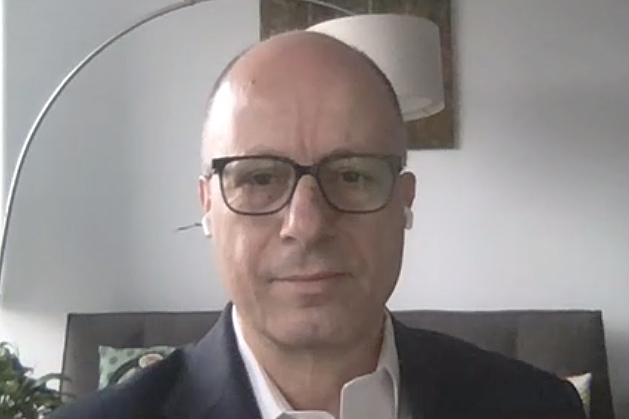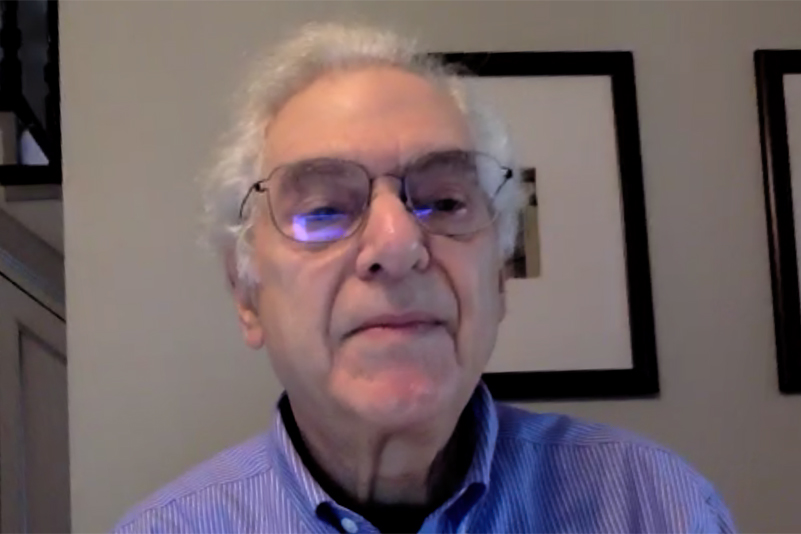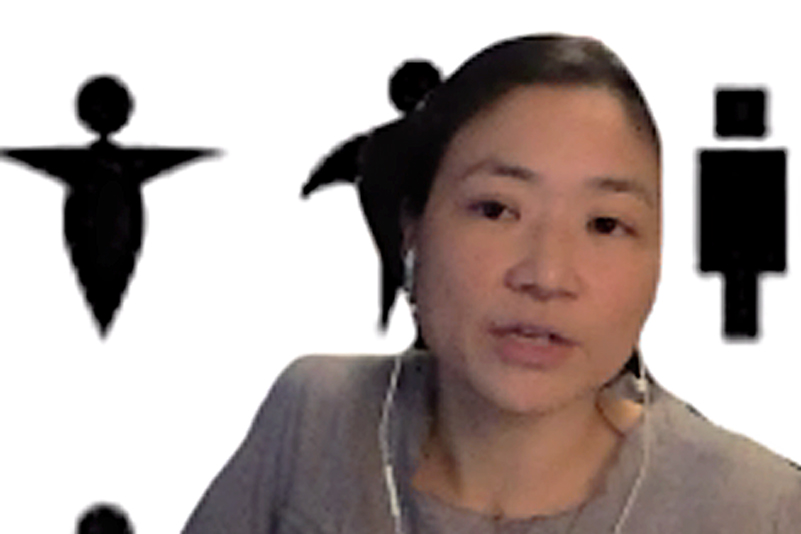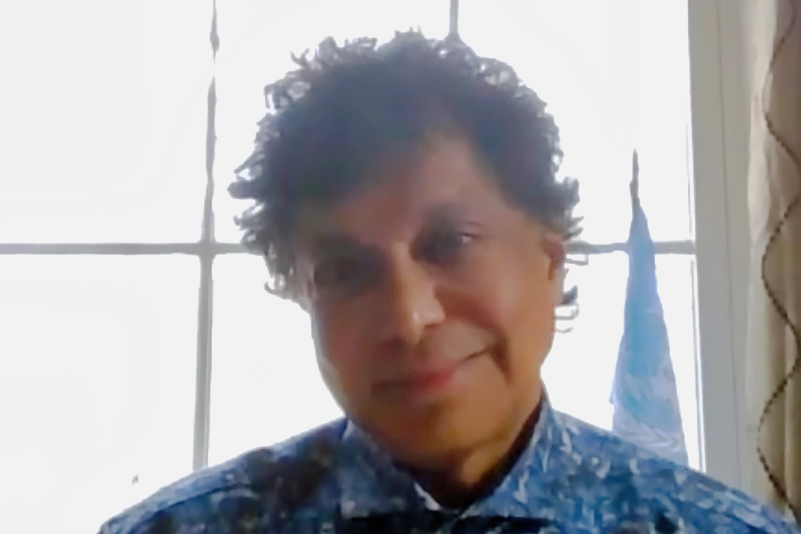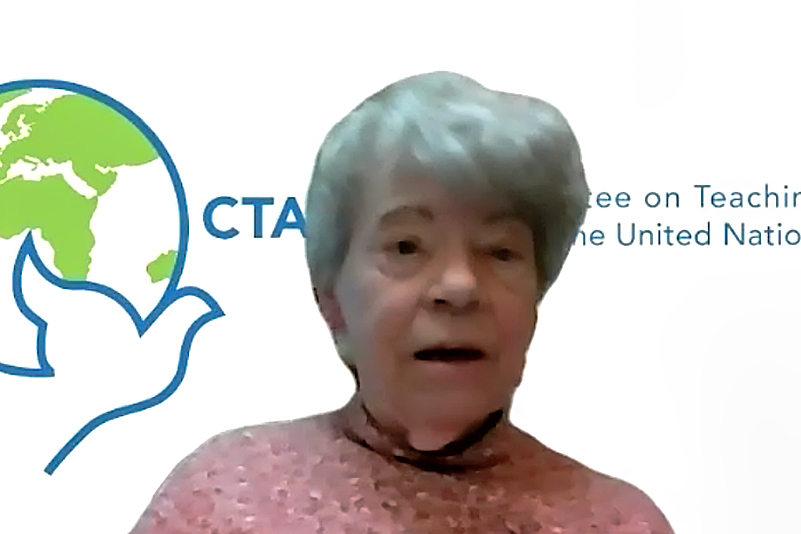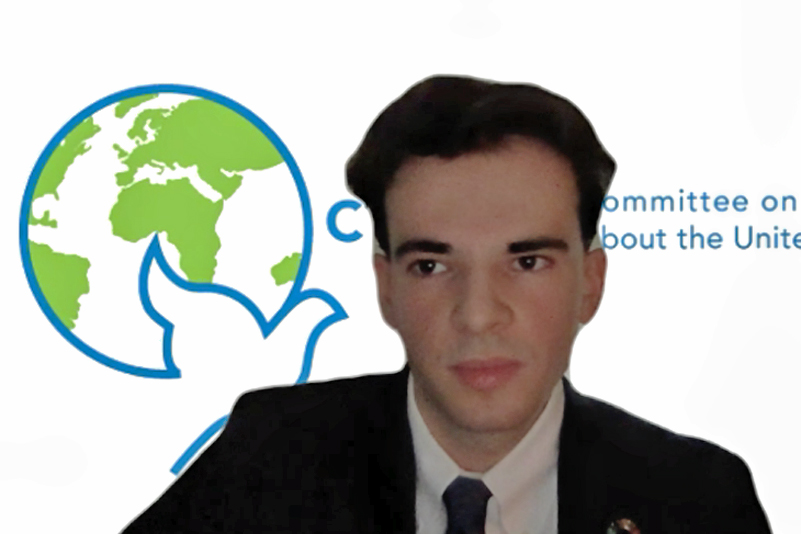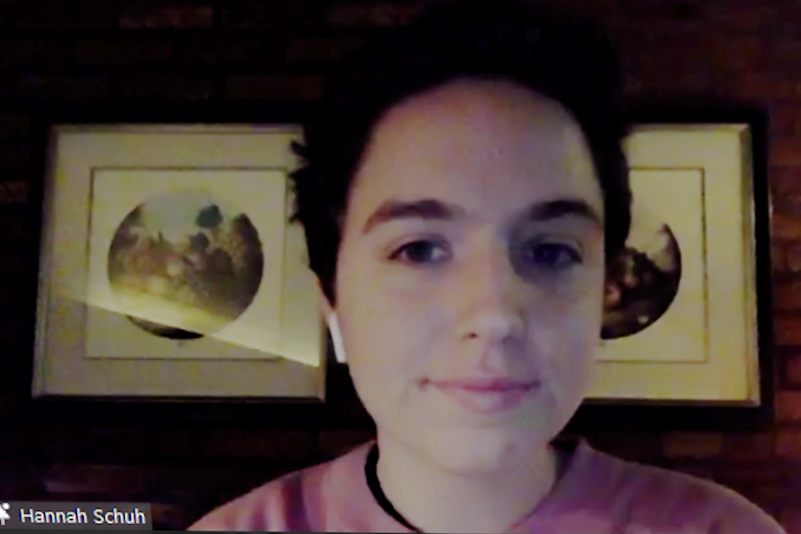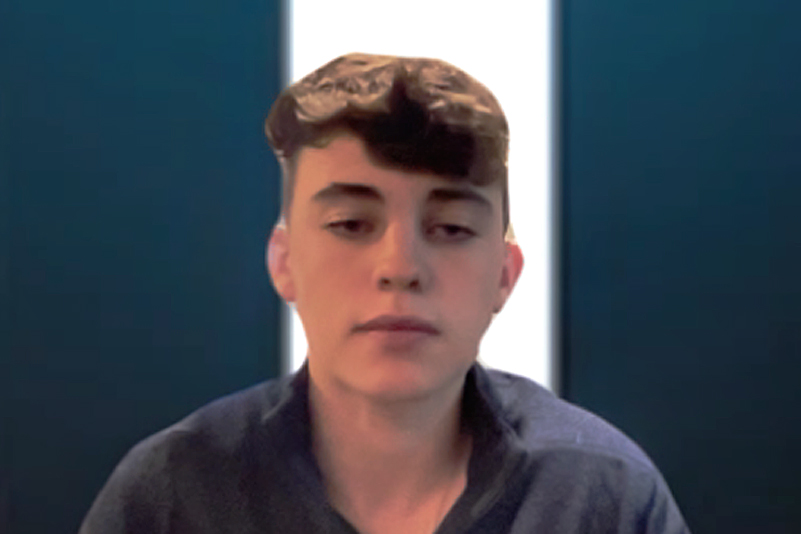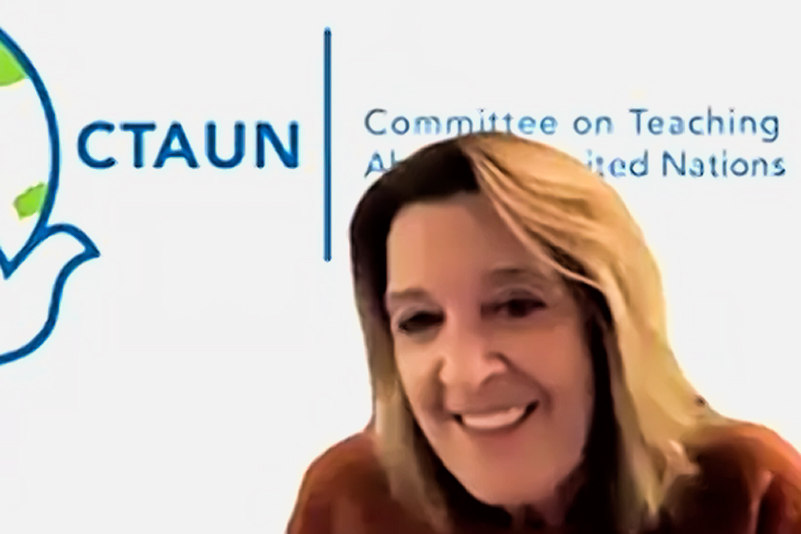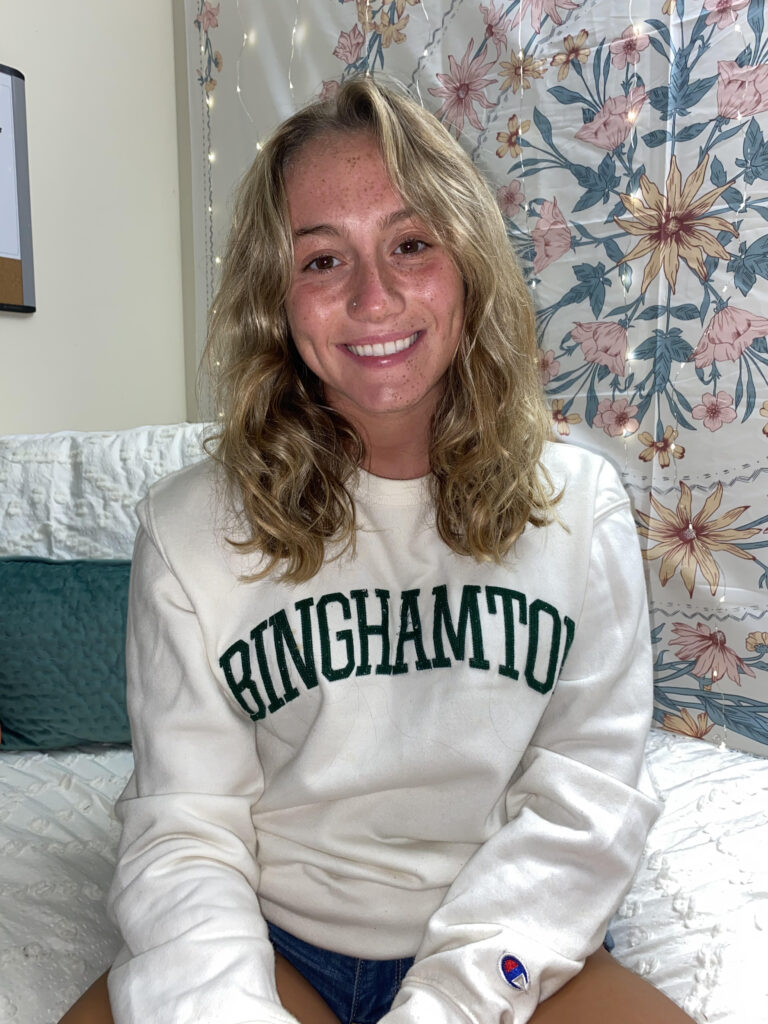2020 UN
War No More
21st CTAUN Conference at the United Nations - Friday 28 February 2020
WAR NO MORE - Honoring the UN on its 75th anniversary and calling for the full implementation of its Charter* "We the Peoples of the United Nations, Determined to Save Succeeding Generations from the Scourge of War... " *Read the full text of the UN Charter
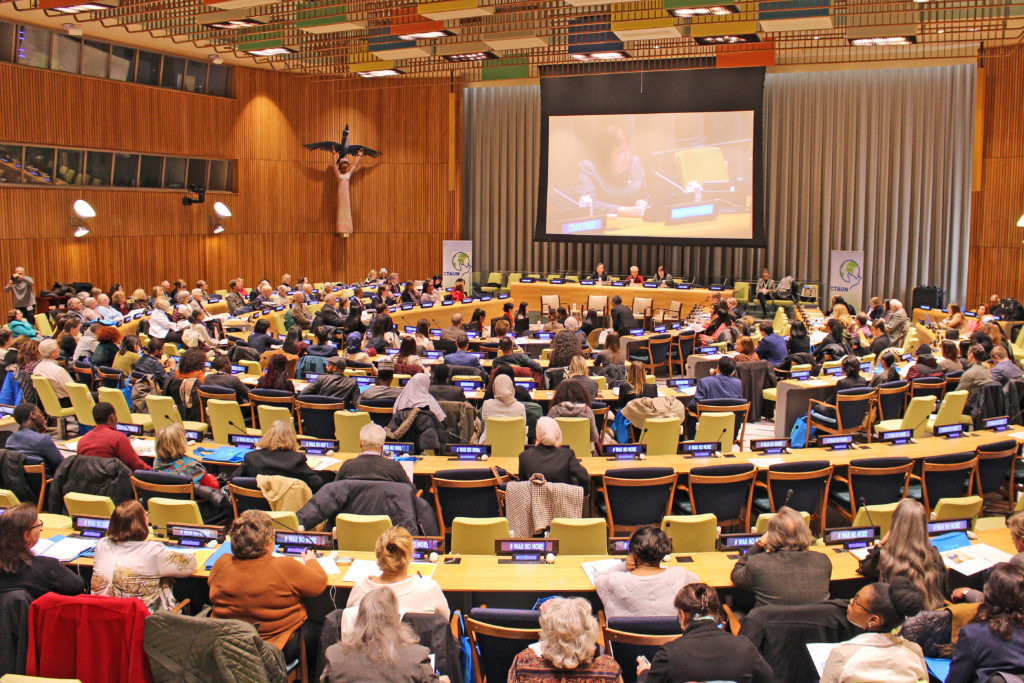
After a WELCOME by Under-Secretary-General for Children in Armed Conflict Virginia Gamba, Ambassador Cho Hyun, Republic of Korea, and CTAUN Chair Anne-Marie Carlson, this all-day Conference was organized around the following conversations:

- CREATING PEACE - The Role of Civil Society and Women in Prevention of War and in Peace Processes - with Leymah Gbowee and Gloria Steinem; Facilitated by Carol Jenkins
- PEACE EDUCATION AND TRANSFORMATIVE EDUCATION - Tony Jenkins, Global Campaign for Peace Education (GCPE); Eunhee Jung, Founder and President of Intercultural Virtual Exchange of Classroom Activities (IVECA); Facilitated by Ramu Damodaran.
- NEW TECHNOLOGIES - Hypersonic, Artificial Intelligence, Drones - with Michael Klare, Senior Visiting Fellow, Arms Control Association; Eleonore Pauwels, Senior Fellow with the Global Center on Cooperative Security; Adaora Udoji, award winning journalist, media innovator and expert in emerging technologies; Facilitated by Mark Wood.
- WOMEN, PEACE AND SECURITY - Mavic Cabrera Balleza, Founder and CEO, Global Network of Women Peacebuilders (GNWP) - with Dinah Lakehal, Mallika Iyer, and Heela Yoon, Young Women for Peace and Leadership; Facilitated by George Lopez
- DISARMAMENT - Under-Secretary-General Izumi Nakamitsu and Randy Rydell, with Camryn Bruno, NYC Youth Poet Laureate; Facilitated by George Lopez
- WORLD PEACE THROUGH LAW: FORCE OF LAW, NOT THE LAW OF FORCE - Ambassador Christian Wenaweser and James T. Ranney, who was Legal Consultant to the UN International Criminal Tribunal for the Former Yugoslavia. Facilitated by Jutta F. Bertran-Nothnagel
- Closing Statement: THE FUTURE WE WANT - Cora Weiss
The conference has been recorded and can be seen on UN webtv as follows:- Part 1 (Morning Session): http://webtv.un.org/en/asset/k1u/k1uvfo7ora
- Part 2 (Afternoon Session): http://webtv.un.org/en/asset/k14/k14gya7fyb
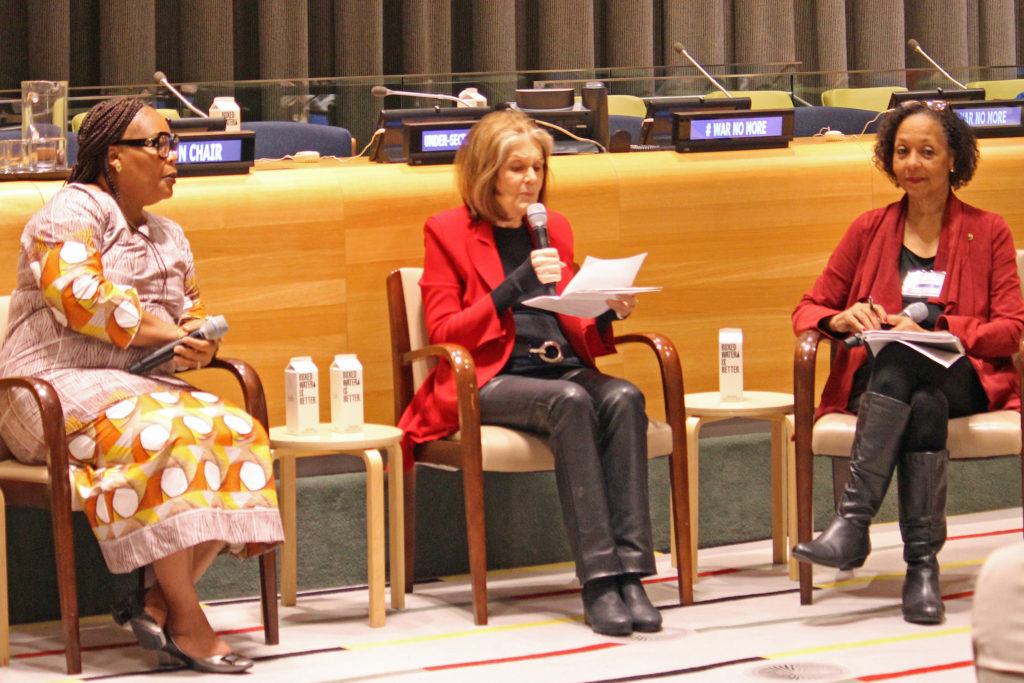
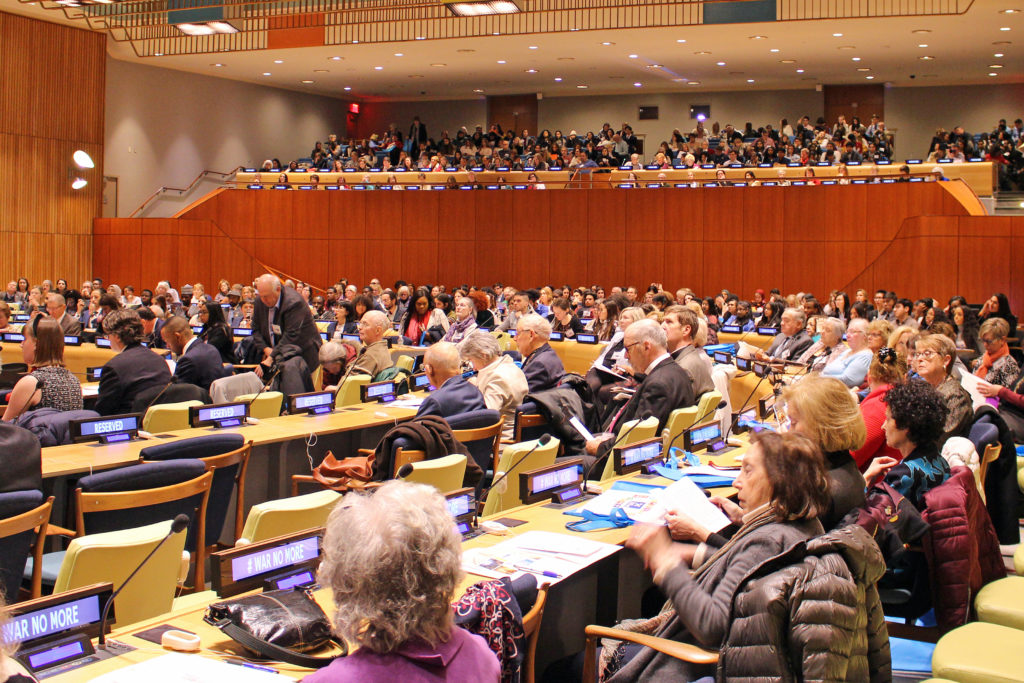
You can also read the following articles:
Committee on Teaching About the UN demands 'War no More'
Peace Begins at Home: Gloria Steinem’s Recipe for a Nonviolent World
War No More: Using Education to Advance Peaceful Coexistence
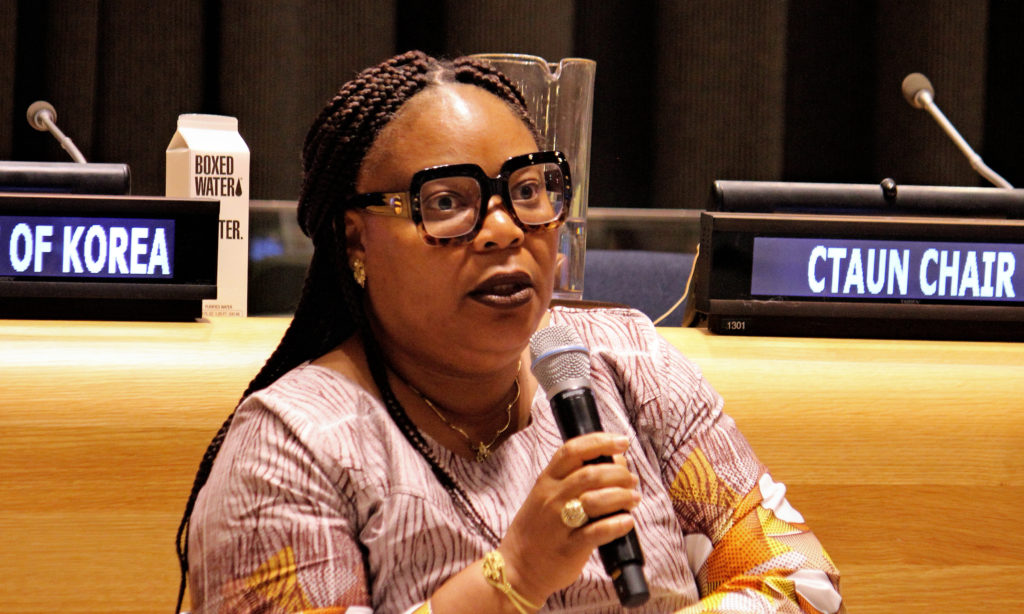
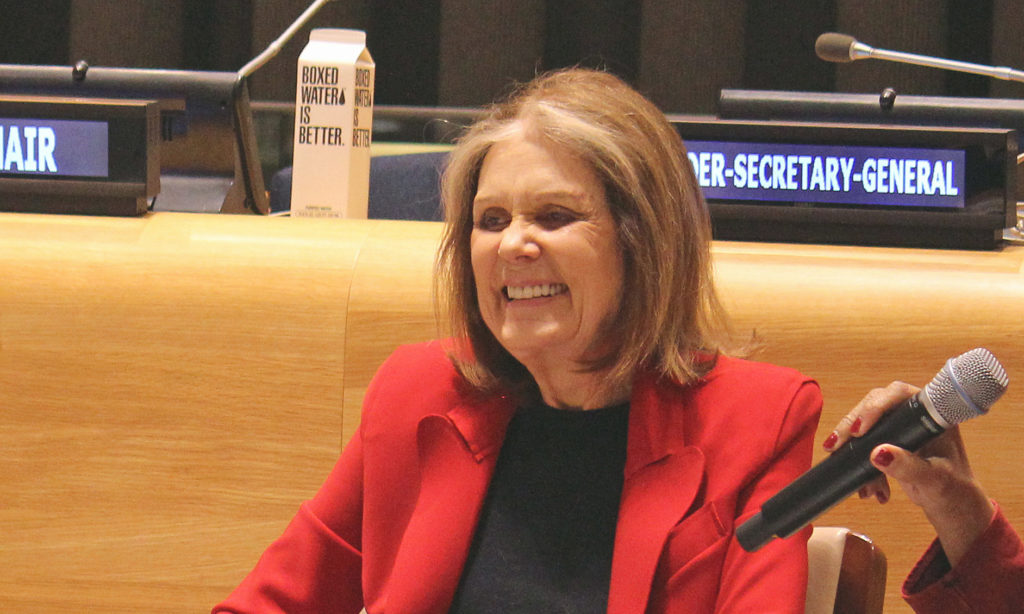
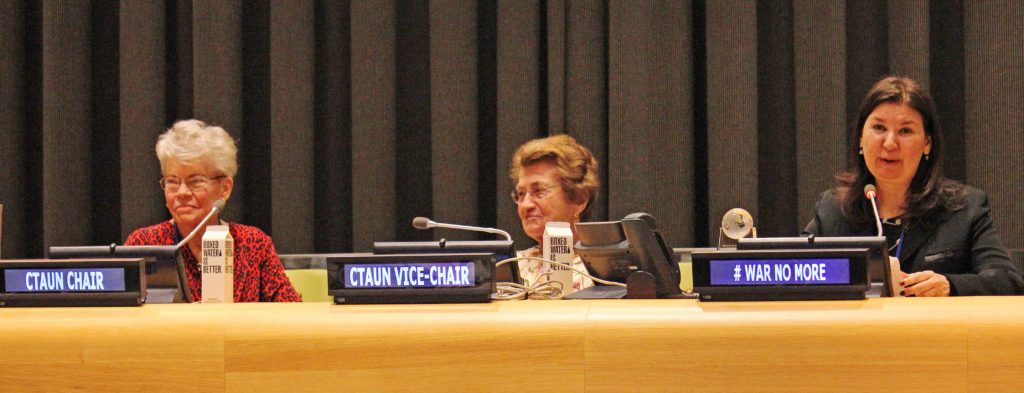
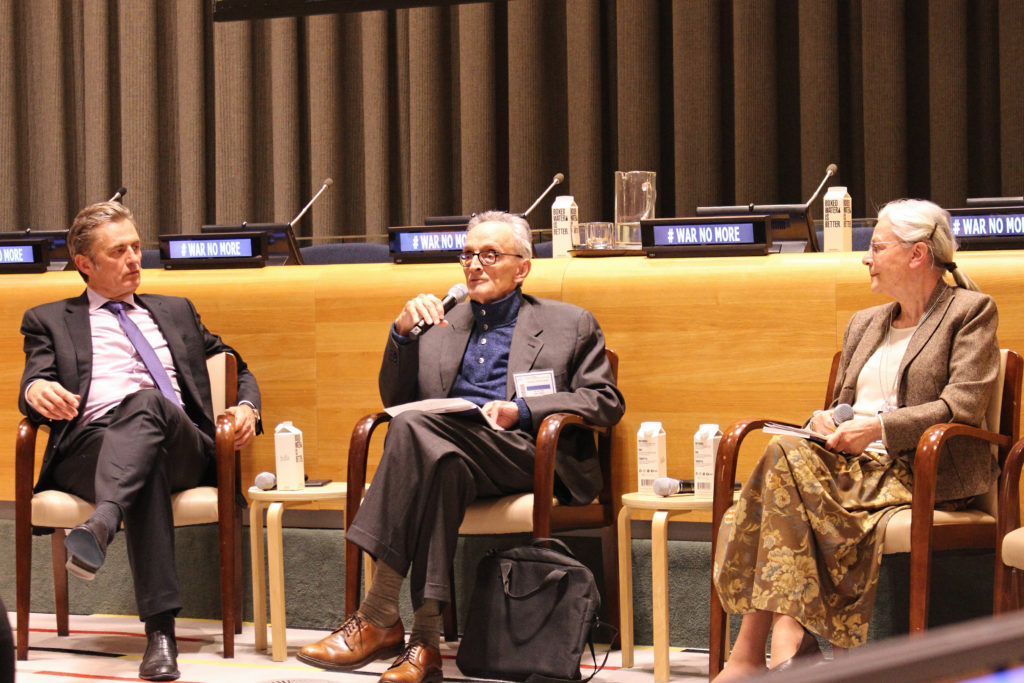
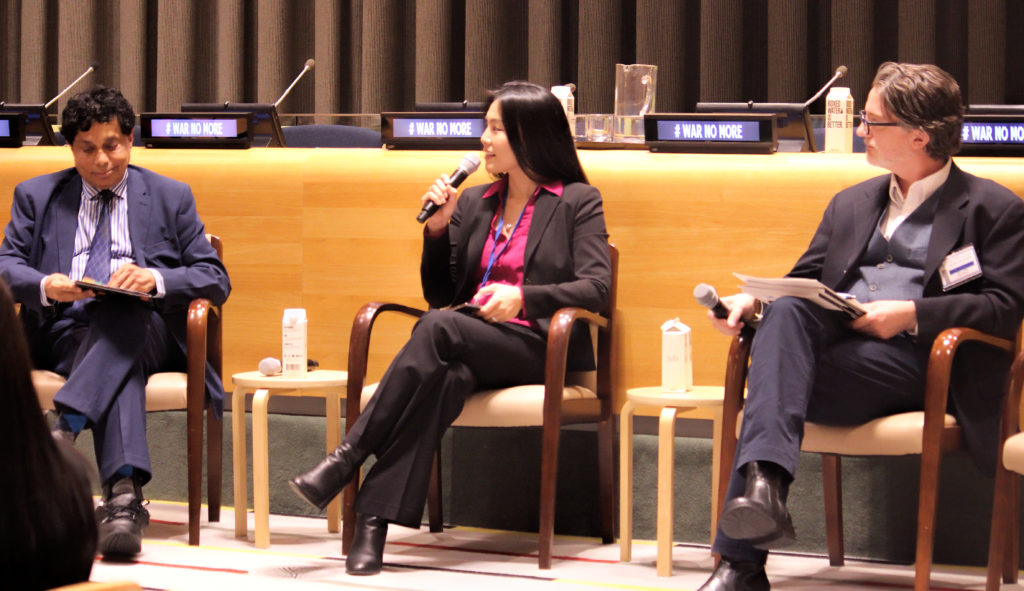
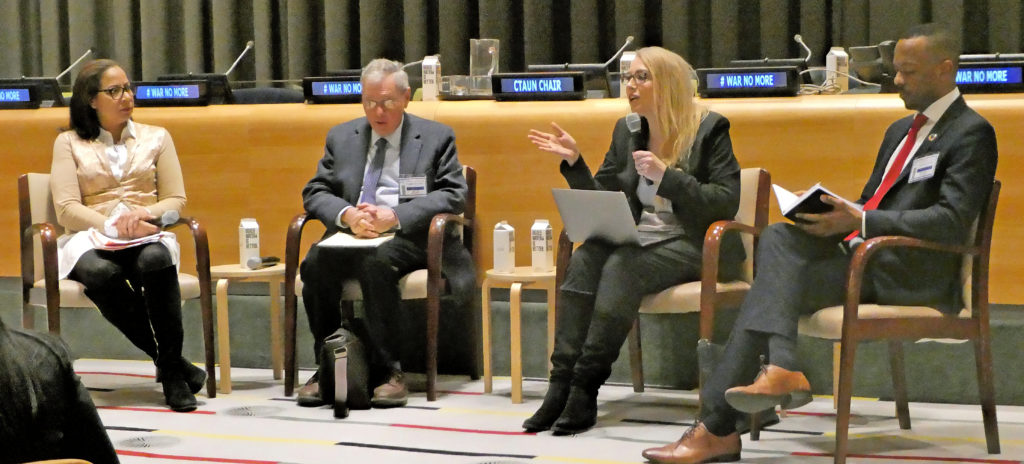
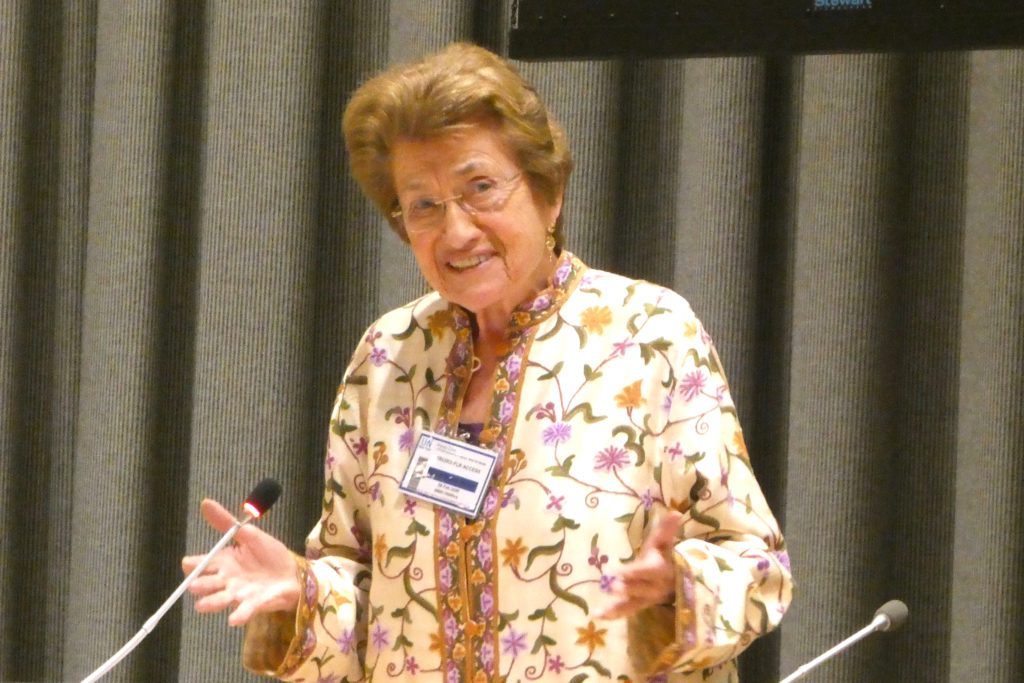
EXHIBITORS AT THE INFOFAIR
- Atom Project (Mission of Kazakastan to the UN) www.TheAtomProject.org
- Childhood Educational International www.acei.org
- CITYarts www.pieces4peace@cityarts.org
- Global Kids www.globalkids.org
- Global Network of Women Peacebuilders www.gnwp.org
- Institute for Economics and Peace www.econoomicsandpeace.org
- International Institute for Peace Education www.i-i-p-e.org
- Korean Mission to the UN www.unescoapceiu.org
- Office of the UNSG Special Representative for Children & Armed Conflict www.childrenandarmedconflict.un.org
- Peace Action www.panys.org
- Peace Boat - US www.peaceboat-us.org
- Somerset County Vocational & Tech School greinanj@gmail.com
- UN Department of Global Communications www.un.org/en/sections/departments/department-global-communications/about-us.org
- UN Women.org www.unwomen.org
- UNA USA www.una-usa.org
- UNIS www.unis.org
- UNODA www.unoda.org
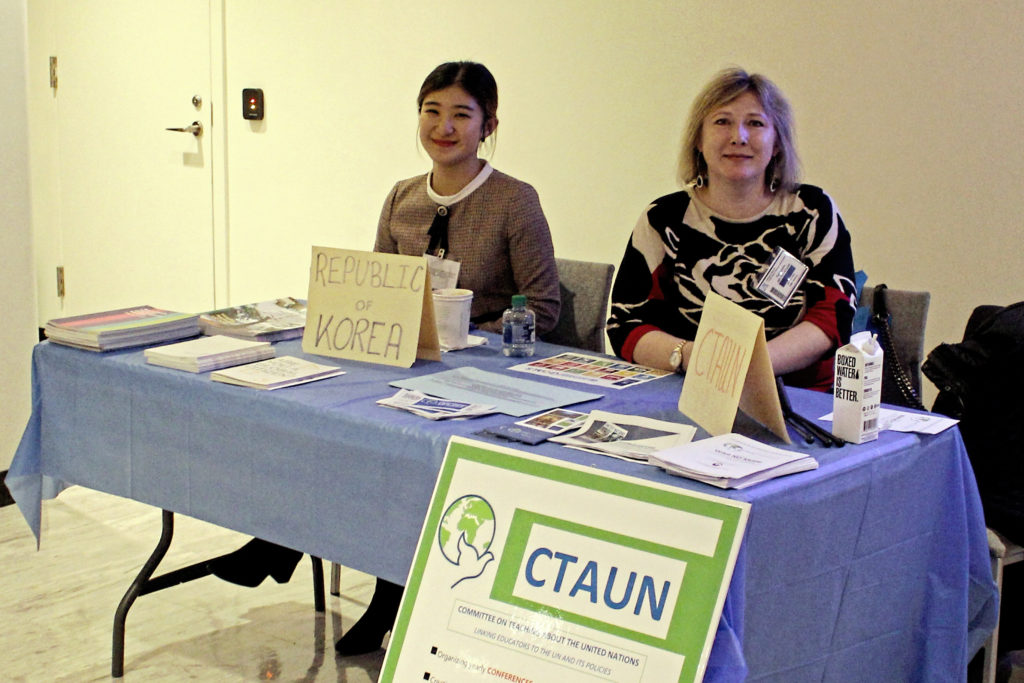
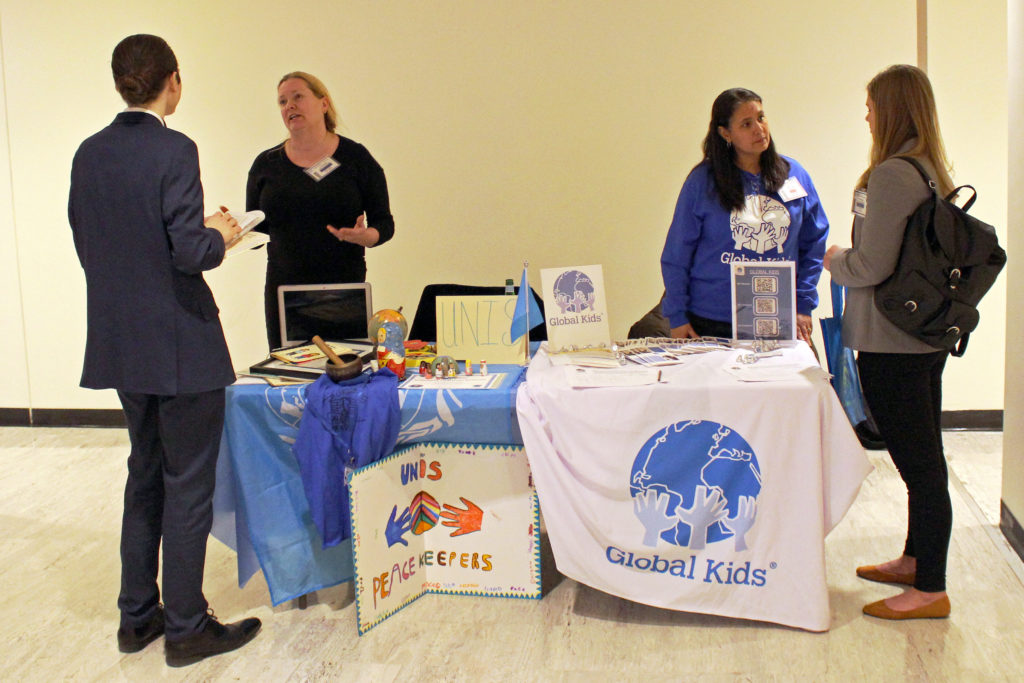
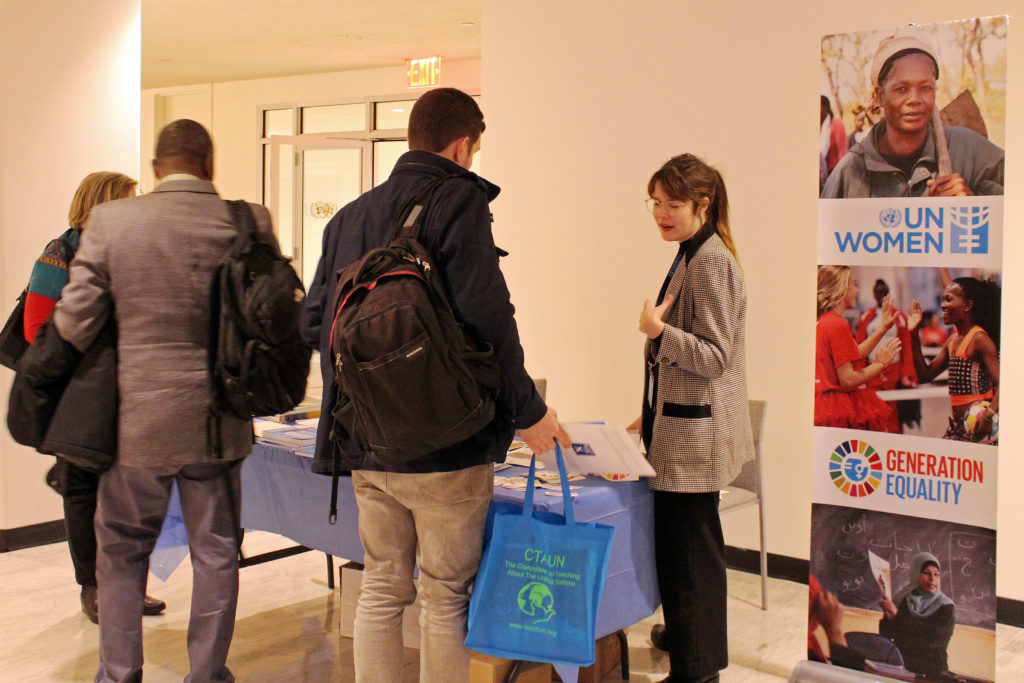
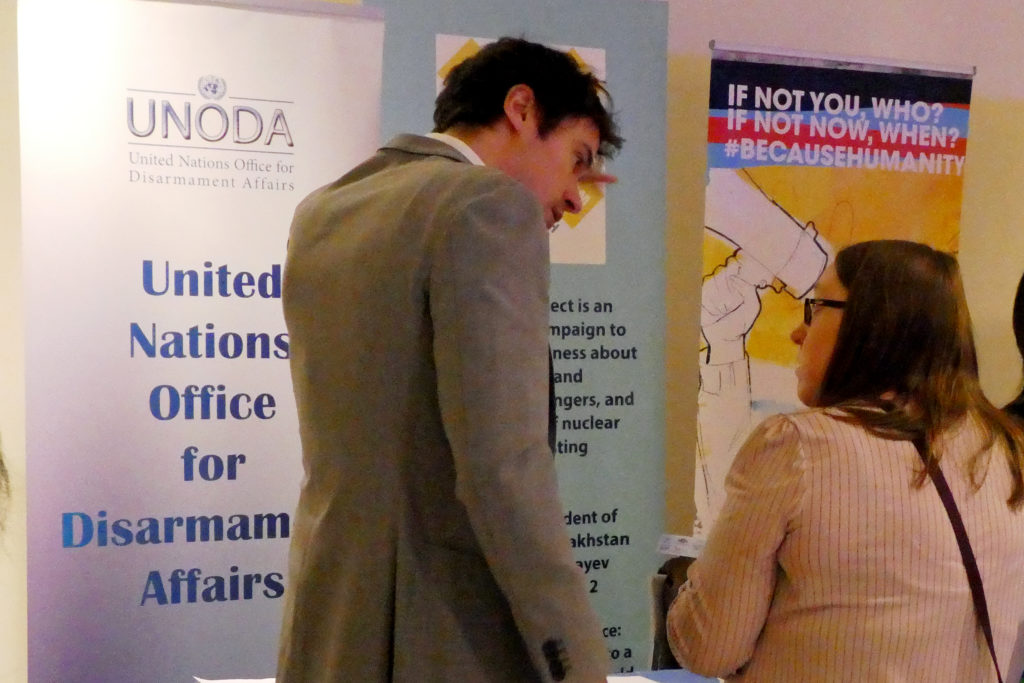
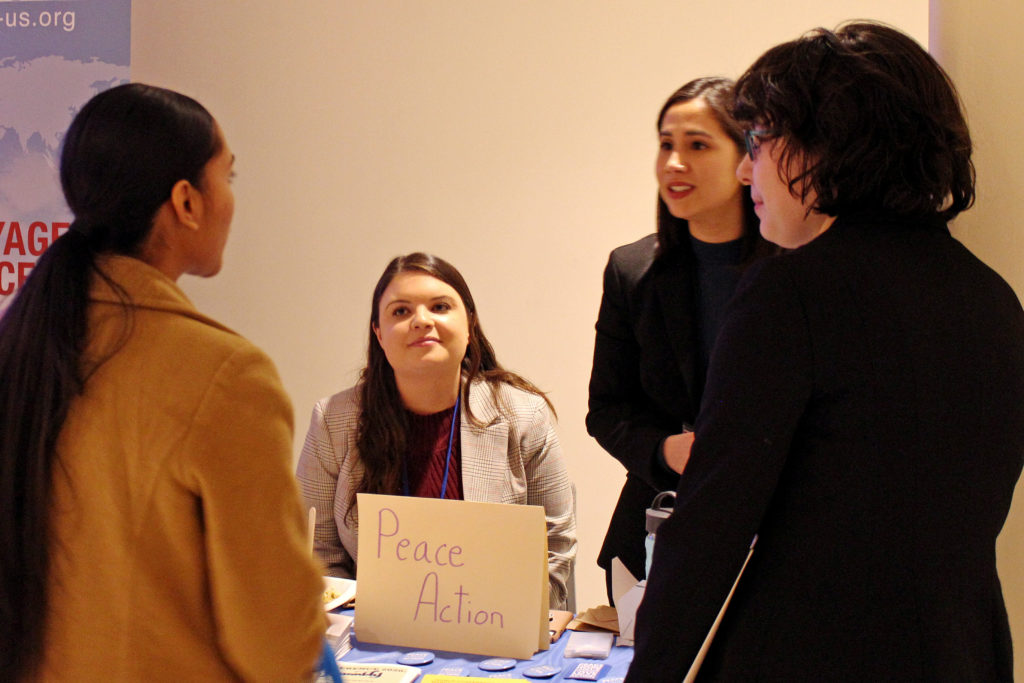
We thank the Co-Sponsors of the Conference:
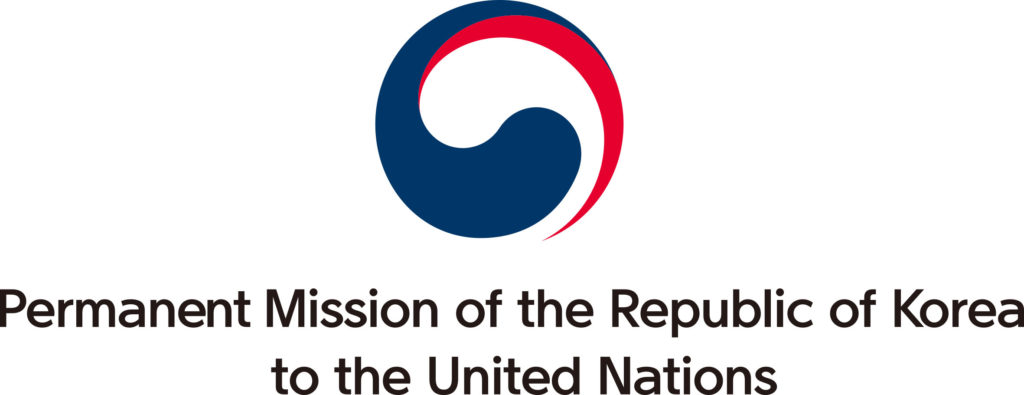
CTAUN also acknowledges with gratitude the partial support from the Korea International Cooperation Agency (KOICA)
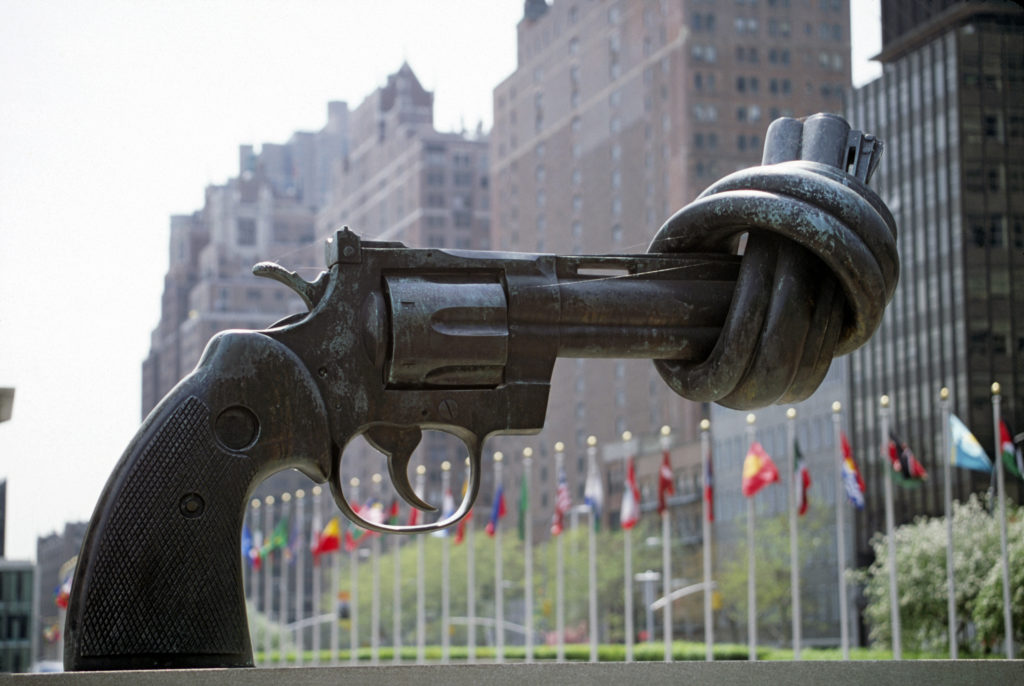
WE HAVE GATHERED A LIST OF RESOURCES TO HELP WITH TEACHING AND LEARNING ABOUT THE CONFERENCE TOPIC "WAR NO MORE"
Books
Primary (picture books)
Can You Say Peace? By Karen Katz (Square Fish, 2016.) International Peace Day is September 21st. Karen Katz takes readers on a bright and colorful journey around the globe to meet some of the children all over the world and learn about the many ways to say peace!
My Wish for Tomorrow: in celebration of the 50th anniversary of the United Nations. (Tambourine Bks, 1995.) Touching wishes, hopes and dreams of children aged 4-12 worldwide, for a better future, along with their drawings.
What Does Peace Feel Like? Illustrated by V. Radansky. (Atheneum Books for Young Readers, Simon & Shuster, 2004.) Uses all the senses to elicit definitions of peace from children. Glossary contains the word ‘peace’ in multiple languages.
Intermediate
Paths to Peace: People Who Changed the World. By Jane Breskin Zalben. (Dutton Children’s Books, 2006.) Beautifully illustrated 1- page bios of peacemakers, with quotes and related works of art, glossary and bibliography of the peacemakers.
Peace Tales: World Folktales to Talk About. By Margaret Read MacDonald (ed.) (Linnet Books,1992.) Folk tales and proverbs on Pathways to War and Pathways to Peace for oral storytellers. Contains notes and source materials for all the stories, a source list for collections of proverbs, and other recommended books.
Rose Blanche By Roberto Innocenti. Mankato, (MN Creative Education, 1985.) The touching story, in picture-book format, of a young German girl who risks her life to feed hungry children behind barbed wire during WWII. Symbolism in the colors of the illustrations and in her name, add depth.
Sadako and the Thousand Paper Cranes By Eleanor Coerr and Ronald Himler. (Puffin Modern Classics, 2004.) The classic true story of the young Japanese girl who struggled with leukemia as a result of radiation sickness from the attack on Hiroshima in 1945, and the thousand origami paper cranes completed by the schoolchildren of Japan in her honor.
When the Wind Blows by Raymond Briggs(Penguin Books, 1988.) A visual parable against nuclear war; all the more chilling for being in the form of a strip cartoon.
Young Adult and Adult
Act of Creation: The Founding of the United Nations. By Stephen Schlesinger. (Westview Press, 2003.) The incredible undertaking at the San Francisco Conference; the geo-political obstacles, negotiating struggles, and compromises necessary to get the 51 original members on board.
All Hell Breaking Loose, The Pentagon's Perspective on Climate Change. By Michael T. Klare. (Metropolitan Books, Cambridge, MA., 2019.)
Exploring Betty Reardon's Perspective on Peace Education. Chapter 15. By Tony Jenkins, Dale Snauwaert, editor, (Springer, 2019.)
Mighty Be Our Powers a Memoir. By Leymah Gbowee. (Beast Books, NY, 2013.) The remarkable tale of her struggle for peace during the long and gruesome civil war in Liberia, and an account of African women and their power to bring about peace when men have failed.
My Life on the Road. By Gloria Steinem. (Random House Publishing Group, 2016.) A memoir and NY Times bestseller.
Notes to the Man Who Shot Me. By John Musgrave. (Coal City Review # 18, 2003.) Moving, ironic poetry, some of it written in the voice of a 17 year-old Marine who appeared later in the Ken Burns/Lynn Novick series on The Vietnam War.
Pathways to Peace: The Transformative Power of Children and Families by James F. Leckman (Editor), Catherine Panter-Brick (Editor), Rima Salah (Editor). (Strungman Forum Reports, 2014.)
Peace They Say: A History of the Nobel Peace Prize. By Jay Nordlinger. (Encounter Books, 2012.) How Alfred Nobel, inventor of dynamite, established the peace prize, and the full panoply of winners from 1901-2012.
The Impact of War on Children. By Graca Michel. (London: Hurst & Co., 2001.) Topics covered include landmines in Mozambique affecting 20,000 people, exploitation of girls as child soldiers and sex slaves, and the efforts of women to reconstruct families and transform schools into safe havens.
The Theatre of War: What Ancient Greek Tragedies Can Teach Us Today. By Bryan Doerries. (NY: Vintage Books, 2016.) Illustrates the use of classic Greek plays related to war with viewers suffering from PTSD in the military, in prisons, and hospice centers, and their cathartic effect.
Waging Peace in Vietnam. Chapter 10, “Bringing POW's Home”, By Cora Weiss. (New Village Press (NYU, NY, 2019.)
What it is Like to Go to War. By Karl Marlantes. (NY: Grove Press, 2011.) A critical examination of the psychological and spiritual aspects of war, and his own experience as a Marine lieutenant in Vietnam. Related film, on the emotional components of Going to War.
World Peace Through Law, Replacing War With the Global Rule of Law. By James Taylor Ranney, (Routledge, 2017.)
Articles
“Autonomous Weapons Systems and the Laws of War” by Michael Klare. https://www.armscontrol.org/act/2019-03/features/autonomous-weapons-systems-laws-war
“Feminist icon Gloria Steinem urges United States to end Korean War” By Yoonjung Seo, Julia Hollingsworth and Jake Kwon. https://www.cnn.com/2019/09/20/asia/gloria-steinem-south-korea-intl-hnk/index.html
“Fifty Years After, A Daunting Cleanup of Vietnam’s Toxic Legacy” By George Black. https://e360.yale.edu/features/fifty-years-after-a-daunting-cleanup-of-vietnam-toxic-legacy-dioxin-agent-orange From 1962 to 1971, the American military sprayed vast areas of Vietnam with Agent Orange. Now, the U.S. and Vietnamese governments have joined together in a massive cleanup.
“How Vietnam, US heal wounds of war to build up comprehensive partnership?” https://english.vietnamnet.vn/fms/society/221192/how-vietnam-us-heal-wounds-of-war-to-build-up-comprehensive-partnership-.html Hanoitimes article describes the partnership between the United States and Vietnam in the last 30 years to improve relationships.
"Hypersonic Missles are Unstoppable. And They're Starting A New Arms Race." By R. Jeffrey Smith. New York Times article in collaboration with the Center For Public Integrity. https://www.nytimes.com/2019/06/19/magazine/hypersonic-missiles.html
“Imagination and Nuclear Weapons” by David Krieger. https://www.wagingpeace.org/imagination-and-nuclear-weapons/?link_id=6&can_id=4352e8f4598c1bbefc07c50a259fd905&source=email-sunflower-newsletter-june-2019&email_referrer=email_557383&email_subject=sunflower-newsletter-june-2019
“Iranians Are Not Our Enemies” by Patrick T Hiller. https://fpif.org/iranians-are-not-our-enemies/ When foreign policy as we know it isn’t working, creative citizen diplomacy can step in to humanize the real people who would be most impacted by war.
“Lessons From a Decade Reporting on Women During the Iraq War” By Hannah Allam. https://lithub.com/lessons-from-a-decade-reporting-on-women-during-the-iraq-war/ Reporting on Women During the Iraq War - Survival, Heartbreak & Laughter in a War Zone
“Nuclear Age Peace Foundation: “Sunflower Newsletter” July 2019 By Rich Wayman. https://www.wagingpeace.org/sunflower-newsletter-july-2019/ Presents writers opinions about the nuclear debates.
“Nuclear weapons: Which countries have them and how many are there" BBC Newsbeat. https://www.bbc.com/news/newsbeat-51091897
“Peace is Not Enough” By Leymah Gbowee. https://www.nytimes.com/2018/09/16/opinion/politics/leymah-gbowee-peace-liberia.html
“The American Cult of Bombing and Endless War” By William J. Astore. https://www.portside.org/2019-06-04/american-cult-bombing-and-endless-war
Curriculum
Ceeds of Peace Toolkit - https://www.ceedsofpeace.org/toolkit-2/ The Ceeds of Peace Toolkit is an important part of a 360º approach to raising to a generation of peacebuilding leaders.
Curriculum of Hope for a Peaceful World - https://dkgct.weebly.com/curriculum-of-hope.html The mission of the Curriculum of Hope for a Peaceful World Committee is to study and promote critical thinking, conflict resolution, and cooperative learning skills toward a more peaceful world. Newsletters share lesson plan resources.
Lesson for SDG 16, World’s Largest Lesson - http://worldslargestlesson.globalgoals.org/global-goals/peace-and-justice/ A collection of lesson plans and resources connected to Global Goal 16, Peace Justice, and Strong Institutions.
Operation Respect - https://operationrespect.org/classroom-lessons/ Lesson plans reflect the belief that all young people deserve, and have the right to learn in a safe, respectful and caring community.
Peace Day, Teacher Planet - https://www.teacherplanet.com/content/peace-day Suggested lessons and activities for International Peace Day, September 21.
Peace Education: A Pathway to a Culture of Peace Third Edition(2019) - https://www.peace-ed-campaign.org/peace-education-pathway-to-a-culture-of-peace/
Peace Education Training Manual for GPPAC-Southeast Asia(2015) - https://www.peace-ed-campaign.org/wp-content/uploads/2016/06/Peace-Education-Training-Manual-for-GPPAC-SEA.pdf A manual for peace educators in Southeast Asia(SEA) focusing on topics or themes most relevant to the Southeast Asian region.
Peace Lessons from Around the World - https://www.peace-ed-campaign.org/peace-lessons-from-around-the-world/ Andrea S. Libresco & Jeannette Balantic, co-editors, Hague Appeal for Peace in Cooperation with the International Advisory Committee of the Global Campaign for Peace Education. This collection of sixteen lessons, from Albania, Cambodia, Philippines, Kenya, India, Nepal, US, Spain, and South Africa, is based on the Hague Agenda for Peace and Justice for the 21st Century.
Peacebuilding Toolkit for Educators, - https://www.usip.org/public-education/educators/peacebuilding-toolkit-educators The United States Institute of Peace. Toolkits for Middle School and High School designed to support the work of educators as peacebuilders.
“Setting the Peace Table: Children & Conflict Resolution” - https://iheartmontessori.wordpress.com/2012/11/27/setting-the-peace-table-children-conflict-resolution/ By Stacy Burnett. Description of Montessori Peace Table set up and protocols.
Teachable Moment Lessons, Morningside Center for Teaching Social Responsibility - https://www.morningsidecenter.org/teachable-moment#views-exposed-form-teachable-moments-filtered-lessons-desktop Timely resources to help K-12 educators encourage social responsibility and foster social & emotional learning.
Teaching Children to Live and Act Peacefully, Peace Study Center - http://peacestudycenter.org/wp-content/uploads/2013/10/PSC-Curriculum-Guide.pdf This curriculum guide includes specific lessons to be used with Peaceful Classroom Posters.
Teach Peace Now - https://teachpeacenow.com/ Website offers books, activities, lesson plans, and ideas that teachers, parents, and students can use to promote values, attitudes and behaviors which encourage non-violent resolution of conflict, respect for human rights, democracy, intercultural understanding and tolerance.
Women Working for Normalization - https://www.mc.edu.ph/Portals/8/Resources/Normalization.pdf Australian Training Manual on “Women Working for Normalization” provides concepts and skills to enable women to take an active part in normalization
Youth for Human Rights - https://www.youthforhumanrights.org/educators.html Teaches Youth about the UN Declaration of Human Rights, and trains them as advocates for tolerance. Provides lesson plans, video and a booklet.
Media - Film & CD
Children of War (Kony Documentary) by Director Brian Single https://www.youtube.com/watch?v=xVi3tCVF3o8&feature=youtu.be Filmed in northern Uganda over a period of three years, an award-winning documentary which follows a group of Joseph Kony's child soldiers as they escape the battlefield, enter the sanctuary of a rehabilitation center, and undergo a remarkable process of trauma therapy and emotional healing.
Determined to Save Succeeding Generations from the Scourge of War – http://vimeo.com/6783824 A graphic and moving portrayal of what war feels like to real people, and why ending it is of utmost urgency. (11 min.)
Making Peace a Real Possibility: Video Interview with Betty Reardon (1985) - https://www.peace-ed-campaign.org/making-peace-a-real-possibility/?utm_source=mailpoet&utm_medium=email&utm_campaign=Making+Peace+Possible+Reardon+Email A summary of Betty’s early work in gender and peace education.
Nobel Women’s Initiative: Emerging Feminists Voices for Peace https://nobelwomensinitiative.org/claiming-our-space-video/ These inspiring activists are leading communities to build peace and break gender barriers.
Pray the Devil Back to Hell: https://vimeo.com/128182384 Bill Moyers Journal profiles Leymah Gbowee, a woman who led her fellow countrywomen to fight for and win peace in war-torn Liberia, and Abigail Disney, who produced the documentary of their struggle and triumph.
Sir! No Sir! – The GI Movement to end the Vietnam War – www.sirnosir.com Documentary of men who went in as volunteers and came out as anti-war activists
To End a War. Trailer https://vimeo.com/205050057 Since 2012 the Colombian Government and FARC have held Peace Talks in Cuba. With unprecedented access to both political leaders, this intimate, insightful documentary goes behind the scenes during this profound moment in history.
The Atomic Tree https://www.globalonenessproject.org/library/virtual-reality/atomic-tree?utm_source=Global+Oneness+Project+Newsletter&utm_campaign=bcfd441a4d-The+Atomic+Tree+Wins+Awards&utm_medium=email&utm_term=0_484790f1e5-bcfd441a4d-196494701 This virtual reality/360 film takes you on an immersive journey into the memories of one of the most revered trees in the world—a 400-year-old Japanese White Pine bonsai that witnessed, and survived, the atomic blast in Hiroshima.
The Man Who Saved the World http://www.unfoldzero.org/26-september-2015/# Stanislav Petrov was responsible for reacting to information from Soviet satellites that five American nuclear missiles were heading toward the Soviet Union. Rather than initiate a nuclear retaliation, Stanislav went against protocol, and assured his colleagues that it was a false alarm.
They Shall Not Grow Old - Affecting documentary of WWI and the teenaged soldiers who experienced it. Produced by Peter Jackson, Available on DVD at Amazon and other venues (trailer on You Tube)
UN Secretary General on Disarmament: https://s3.amazonaws.com/unoda-video/sg-video-message/msg-sg-disarmement-agenda-21.mp4
War Letters – From PBS’s American Experience 1/21/14 - PBS Passport or https://www.pbs.org/wgbh/americanexperience/films/warletters/ Articulate, heart-wrenching, poetic and sometimes ironic letters sent home during America’s wars from the Revolution to Kuwait. Visuals are beautifully edited to match the letters.
The Whistleblower of My Lai – http://clarityfilms.org/mylai.html A group of committed musicians create an opera to tell the tragic story of Hugh Thompson, the 21 year old helicopter pilot who saved 12 lives of the 500 civilian elderly-men and women, and children killed in the massacre. Tackles the concept of heroism, the definition of morality in wartime and guilt – both personal and national.
Women, War and Peace (Trailer) Fork Films https://www.pbs.org/wnet/women-war-and-peace/video/women-war-peace-series-ii-x7sn07/ Discover how some of the biggest recent international events have been shaped by women in a showcase of four, female-directed films that tell never-before-told stories about women who risked their lives for peace, changing history in the process.
Organizations
The American Foreign Service Association - www.afsa.org For young people interested in the foreign service, they conduct an annual National High School Essay Contest in partnership with the Semester at Sea study abroad program.
Children and Armed Conflict – http://childrenandarmedconflict.un.org A department of the UN that works to eliminate child recruitment, killing and maiming, sexual violence, attacks on schools and hospitals, abduction and denial of humanitarian access, as well as providing information on the changing nature of conflict, internally displaced children, children in detention and landmines
Fellowship of Reconciliation – http://forusa.org Their goal is to shift the collective unconscious from a fear-based military culture to one grounded in faith and justice. One initiative is their “I Will Not Kill” youth movement against gun violence and war. They supply videos, a fellowship magazine “Witness”, a newsletter, blog, books, greeting cards, music and films.
The Global Campaign for Peace Education - https://www.peace-ed-campaign.org/ A non-formal, international organized network that promotes peace education among schools, families and communities to transform the culture of violence into a culture of peace.
The Global Network of Women Peace Builders - https://gnwp.org/ A coalition of women’s groups and other civil society organizations from Africa, Asia and the Pacific, Latin America, Eastern and Western Europe and the Middle East and Arab World, mostly from conflict-affected countries. GNWP Board, management and staff are experts in advocating for women’s leadership to be at the core of all efforts in peacebuilding, conflict prevention and sustaining peace.
International Committee to Abolish Nuclear Weapons (ICAN) - https://www.icanw.org/ The international campaign to stigmatize, prohibit & eliminate nuclear weapons.
International Institute on Peace Education - https://www.i-i-p-e.org/ The International Institute on Peace Education is a weeklong residential experience for educators hosted in a different country every other summer. The Institute facilitates exchanges of theory and practical experiences in teaching peace education and serves to grow the field.
Miracle Corners of the World – www.mcwglobal.org empowers youth to become positive agents of change in their local communities, through an annual Global Youth Development Program, that brings participants worldwide to leadership retreats in NY and VT. Their Alumnae Ventures Fund provides recent retreat graduates with start-up funding and mentorship. They will also send speakers to schools and community organizations.
New York Peace Institute - https://nypeace.org/ New York Peace Institute is committed to promoting peace in our communities. They work in the following areas: Mediation, Conflict Coaching, Group Facilitation, and Restorative Justice.
Nonviolent Peace Force – www.nonviolentpeaceforce.org - Protects civilians in violent conflicts through unarmed strategies. Build peace side by side with local communities. Advocate for the wider adoption of these approaches to safeguard human lives and dignity.
Nuclear Age Peace Foundation - www.wagingpeace.org To abolish nuclear weapons and foster global attention to the rule of law, they run an annual poetry contest on visions of peace in 3 categories: adult, youth 13-18, age 12 and under. Winners are published in the Waging Peace, quarterly report.
Peace Boat US - http://www.peaceboat-us.org/ Founded in New York City in 2005, inspired by the belief that the opportunity to experience a Peace Boat voyage – peace-building around the world through people-to-people connection and cooperation – should be available to as many people as possible.
Peace First - https://www.peacefirst.org/ Peace First is a non-profit organization dedicated to helping young people around the world to become powerful peacemakers by: Investing in their ideas, Providing them with tools and skills, Connecting them with other awesome young people around the world, Sharing their stories and impact with the world.
Peace Jam: Youth and Nobel Laureates Working Together to Change the World – www.peacejam.org Uses the life, struggles and work of Nobel laureates as role models. Program is divided into 5 groups: Juniors- aged 5-10, explore the childhood of 13 Nobelists; Leaders – 11-14 study their adolescence; ambassadors – 15-19 confront issues of peace & social justice in their work; Scholars program, ages 18-25, is for those who serve as mentors at youth conferences.
Peace Works: Peace Education Foundation - https://peaceeducation.org/ Educating children and adults in the dynamics of conflict and promoting peacemaking skills in our homes, schools, community, the nation, and the world.
Sandy Hook Promise - https://www.sandyhookpromise.org/ Based in Newtown, Connecticut, the intent is to honor all victims of gun violence by turning our tragedy into a moment of transformation by providing programs and practices that protect children from gun violence.
Seeds of Peace - https://www.seedsofpeace.org is a leadership development organization founded in 1993. Its mission is to inspire and cultivate new generations of global leaders in communities divided by conflict by equipping exceptional youth and educators with the skills and relationships they need to accelerate social, economic, and political changes essential for peace.
Southern Poverty Law Center - https://www.splcenter.org/ The SPLC is dedicated to fighting hate and bigotry and to seeking justice for the most vulnerable members of our society. Using litigation, education, and other forms of advocacy, the SPLC works toward the day when the ideals of equal justice and equal opportunity will be a reality.
Teaching Tolerance - https://www.tolerance.org/ Their mission is to help teachers and schools educate children and youth to be active participants in a diverse democracy. Their teaching kits and lesson plans emphasize social justice and anti-bias.
United States Institute of Peace - https://www.usip.org/ USIP is a national, nonpartisan, independent institute, founded by Congress and dedicated to the proposition that a world without violent conflict is possible, practical, and essential for U.S. and global security. In conflict zones abroad, the Institute works with local partners to prevent, mitigate, and resolve violent conflict.
Universal Peace Federation www.peacefederation.org Of interest to teachers is their character education initiative. They offer a textbook series in workbook format “Discovering the Real Me” for grades k-12.
Women’s International League for Peace & Freedom https://www.wilpf.org WILPF advocates that women lead the way to change, and that peace is only possible when more women with feminist approaches will hold more positions of power, responsibility, and influence.
Projects
Gun Free Valentine Campaign - https://mailchi.mp/iansa/gun-free-valentine-campaign-3390997 An initiative to alert women to the risks of a gun in the home, intimate partner violence, and how laws can be used to save lives. The campaign ends on Int. Women’s Day, Mar 8th.
Pieces for Peace - https://www.cityarts.org/pieces-for-peace-workshops Join thousands of youth from around the world in this art project envisioning PEACE!
The Peace Signs Project - https://spark.adobe.com/page/e78aHOpQ4IskL/ Classrooms around the world are invited to sign up, create signs of peace with their students, and organize student silent demonstration marches in their schools or communities.
World Peace Song Project - https://www.facebook.com/groups/741169739394984/ In this project, based on
World Peace Song teachers and students living in different parts of the world
collaborate to create a global chorus to express peace and build a Peace Song Map.
https://tinyurl.com/r3tuumy
Reports
In Spite of the Conflict, Violence, Disappearances, Women Weave Social Fabric of Communities for Leadership, Resilience, Peace WUNRN, Women’s UN Report Network http://iknowpolitics.org/en/news/world-news/colombia-spite-conflict-continued-violence-disappearances-femicide-women-weave
Militarism Mapped 2019 - https://worldbeyondwar.org/militarism-mapped An updated 2019 mapping of militarism in the world.
Preventing Mass Atrocities By Peter Ackerman and Hardy Merriman - https://www.nonviolent-conflict.org/right-to-assist/ Report outlining research about the impact of civil resistance on society.
SIPRI Year Book 2019: International Peace Research Institute - https://www.sipri.org/sites/default/files/2019-08/yb19_summary_eng_1.pdf Summary of data in areas of armament, disarmament, armed conflicts, peace, and international security.
Three Decades of Peace Education in the Philippines - https://www.mc.edu.ph/Portals/8/Resources/3-Decades-of Peace-Education.pdf Stories of Hope & Challenges and how the Filipino people through initial and continuing efforts, pro-moted peace education.
US Secretary General Quick Guide. Disarmament agenda - https://www.un.org/disarmament/sg-agenda/en/ Secretary-General Antonio Guterres’ agenda for disarmament.
Vision of Humanity Organization: “Global Peace Index 2019” -http://visionofhumanity.org/app/uploads/2019/06/GPI-2019-web003.pdf Ranks 163 independent states and territories on their level of peacefulness, the cost of violence, and how to develop peaceful societies.
Women Speak: Perspectives on Normalization - https://www.mc.edu.ph/Portals/8/Resources/Women_Speak_2014.pdf Outlines the perspectives shared by women on their role in normalization and provides steps to ensure women’s active participation and consideration in the peace process.
Webinar: Combating a Pandemic of Misinformation
In this age of Covid-19, the rapid spread of misinformation may be as dangerous as the virus itself. On Tuesday, 8 December 2020 CTAUN organized a special online presentation examining why people believe and spread misinformation, and invited media professionals to offer techniques and resources that help students (and educators) recognize “red flags”of misinformation (“fake news”). Our Student Panel directed particular attention to Social Media, and we heard from UN communications professionals about special initiatives underway to stem the spread of misinformation, including how educators and students can participate in this effort.
Our speakers included:
Maher Nasser, Director of the Outreach Division, United Nations Department of Global Communications
Ramu Damodaran, Chief, United Nations Academic Impact
Irwin Arieff, Journalist and Editor, Reuters (ret.); contributor to PassBlue
Yoo Kyung Chang, Teachers College, Columbia University
Eileen Venezia and Peter Brosnan, CTAUN Directors, led a Youth Panel composed of High School and College Students Gianna Barcia, Sean O'Hagan and Hannah Schuh who shared their Social Media savvy and advice.
You can watch the recording of the event HERE
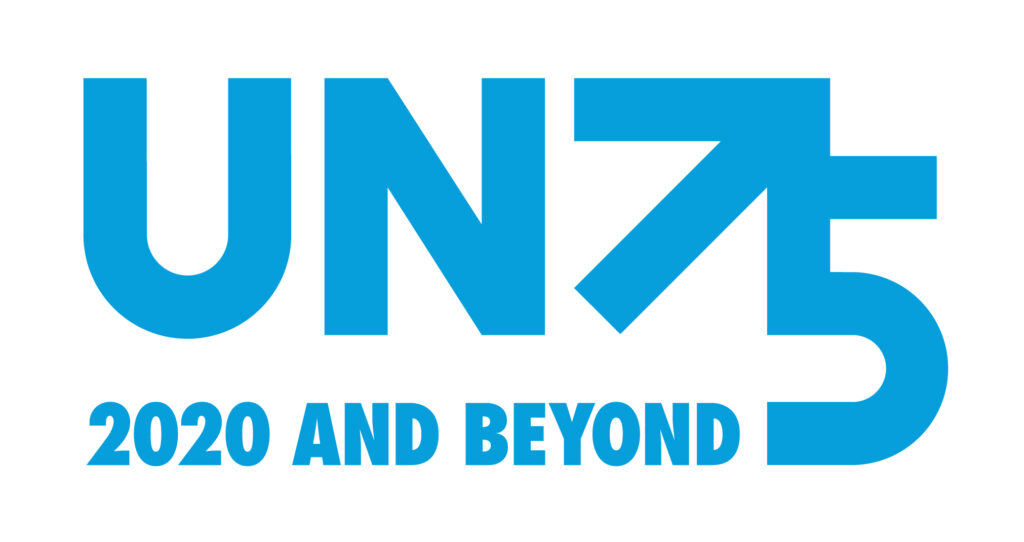
RESOURCES FOR EDUCATORS - a few samples are listed here; come back to this website as additional resources will be posted.
News Decoder: Download a brochure on News Decoder’s media literacy program, offered by the Paris-based nonprofit in partnership with schools around the globe. The program promotes education on good journalism practices for aspiring young journalists as well as resources for the instruction of media literacy for young media consumers. Schools pay an annual fee to partner with News Decoder on such instruction, but financial aid is available for schools that may lack the necessary resources.
Common Sense, a nonprofit, provides a useful online lesson plan for teachers striving to teach media literacy, including discussion points, a video and follow-up suggestions. The lesson is entitled, “Is Breaking News Broken?”
The News Literacy Project, a nonpartisan educational nonprofit, “provides programs and resources for educators and the public to teach, learn and share the abilities needed to be smart, active consumers of news and information and equal and engaged participants in a democracy.”
From The New York Times, here is a detailed lengthy lesson plan for teaching media literacy. Entitled, “Evaluating Sources in a ‘Post-Truth’ World: Ideas for Teaching and Learning About Fake News,” it provides a step-by-step study guide on how to think about media misinformation and how to evaluate whether something is fake news or real news.
A Pandemic of Misinformation: Teaching Digital Literacy -- Glossary
Alt- Right: Reactionary group (s) whose attitudes and behavior result in galvanizing controversy
Bots: A bot is a software application that is programmed to do certain tasks. Bots are automated, which means they run according to their instructions without a human user needing to start them up.
Chatbot: Talking via written questions online
Circular Reporting
1) Publication A prints misinformation
2) Publication B reprints it
3) Publication A cites B as its source - see Princeton Univ Library
Click-Bait: Internet content whose main purpose is to attract attention and encourage visitors to click on a link to a particular web page.
Coding: Computer programming that allows people to write instructions that the computer will execute
Cognitive Dissonance: Used to describe the mental discomfort that results from holding two conflicting beliefs, values, or attitudes, or when our behavior is out of sync with our values. People tend to seek consistency in their attitudes and perceptions. So we attempt to relieve this tension by rejecting, explaining away, or avoiding new information. To read more, including causes, impact, and potential pitfalls go to www.verywellmind.com
Confirmation Bias: A result of cognitive dissonance - The willingness to believe what conforms to our preconceptions. These have a hard time breaking through our filter bubbles, as fact checking is not as exciting as conspiracy theories.
Cookies: A small file loaded onto your browser that recognizes your log-in data, monitors your behavior and personal preferences through the sites you’ve visited, and then presents you with more of the same. eg pop-up ads, films similar to what you’ve selected on Netflix. Negatively, it can be an attack on your privacy.
Disinformation: Deliberate distortion of information intended to deceive public opinion
Fake News: What was once called ‘yellow journalism’ – news stories that have no factual basis, but are presented as fact; propaganda or hoaxes spread via traditional news media or social media - (See Red Flags for Variations). It can also be used to discredit anything that seems hostile to someone’s specific agenda.
False Dilemma: Also known as the all-or nothing fallacy, false dichotomy, either-or reasoning, black and white thinking, polarization with no middle ground - when 2 choices are presented where more exist, or a spectrum of choices exist between two extremes eg. “Either you’re with me or against me.”
Filter Bubbles: Our natural tendency to filter out what we find unbelievable or potentially false
Glass Cliff: The risk of failure
Habit Triggers: Elements in the environment that trigger a habitual response. Most people are not conscious of their habits, and in a stimulus saturated environment are susceptible and responsive to cues that are emotional rather than logical. eg. Craving chips and beer when watching a football game on TV
Infodemic: An overwhelming amount of information
Lateral Reading: When professional fact checkers attempt to establish the credibility of a piece of information, they turn first to multiple well- established, authoritative sites and read several of them to get their perspectives on the topic, piecing together different bits of information from across the web. Only when they’ve gotten their bearings from the rest of the network do they re-engage with the content on the original site
Loss Aversion: We’re more sensitive to losing than we are about winning - our vulnerabilities can be leveraged against us. Loss aversion is the irrational obsession with preventing loss. Examples: taking advantage of an extended warranty, or people desperate to avoid losing their homes becoming prey to subprime lenders
Malinformation: True information that is distorted or taken out of context
Misinformation: Incorrect information of any kind, whatever the intention or source
News Desert: Local news outlets are hardest hit by cuts and layoffs. In many parts of the country no local outlets exist. This creates a ‘news desert’ opening the door for misinformation to thrive.
News Literacy: The ability to use critical thinking skills to judge reliability and credibility of news reports, including photos and videos, whether they come via print, TV, Internet, or social media
Parler: A recent controversial, conservative social media platform, purporting to uphold the 1st Amendment by refusing to block any content, however false, misleading or dangerous
Phishing: The fraudulent practice of masquerading as a reputable company, and duping a victim into opening an email, instant message or text message in order to steal sensitive personal data such as log-in information, or credit card numbers (See Red Flags for most common signs of phishing)
Post Truth: Circumstance in which objective facts are less influential in shaping public opinion than appeals to emotion or personal belief.
Primary Source: an original fundamental and authoritative document pertaining to an event or subject of inquiry; a firsthand or eyewitness account of an event. Some examples of primary sources are letters, manuscripts, diaries, journals, newspapers, speeches, interviews, memoirs, documents from government agencies, photographs, audio and video recordings, research data, objects, and artifacts.
Provisional Truth: Though they don’t doubt what they know, provisional truth is an acknowledgement by scientists that their understanding of our natural world is incomplete, and that science is continually working to know more.
Red Herring: Something irrelevant to the topic that distracts from the main issue
Secondary Source: Secondary sources are works that interpret or analyze historical events or phenomena. They are accounts or interpretations of events created by someone without first hand experience. One step removed from the subject, secondary sources are the result of someone else's contemplation and synthesis of primary sources.
Social Proof: The tendency to decide something is right because other people like me are doing it
Synthetic Media: The attempt to create a fake news site that closely and deceptively resembles a real or well-known one
Woke: Alert to prejudice


